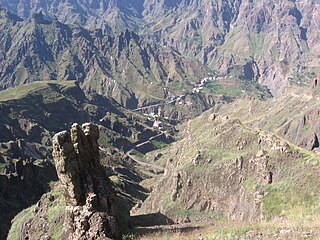| Ribeira da Garça | |
|---|---|
 The Garça Valley at Chã da Igreja in 2008, since 2014, the road crosses through and behind the cliff is the Canto de Cagarra Dam | |
| Country | Cape Verde |
| Physical characteristics | |
| Main source | Gudo de Cavaleiro, Santo Antão |
| River mouth | Atlantic Ocean 17°09′58″N25°10′12″W / 17.166°N 25.170°W Coordinates: 17°09′58″N25°10′12″W / 17.166°N 25.170°W |
| Length | 8 km (5.0 mi) |
Ribeira da Garça [1] is a river in the northern part of the island of Santo Antão in Cape Verde. Its source is on the north side of the main range of the island. It flows north through the settlements of Garça de Cima and Chã de Igreja and the west of the municipality of Ribeira Grande, and drains into the Atlantic Ocean in the north nearly 10 km west of Ribeira Grande. Hamlets located near or by the stream includes Horta da Garça, Cagarra, Manta Velha and Fundo. Parts of the river features some cliffs that are 30 to 40 meters high.

Santo Antão is the westernmost island of Cape Verde. At 779 km2 (301 sq mi), it is the largest of the Barlavento Islands group, and the second largest island of Cape Verde. The nearest island is São Vicente to the southeast, separated by the sea channel Canal de São Vicente. Its population was 40,547 in 2015, making it the third most populous island of Cape Verde after Santiago and São Vicente. Its largest city is Porto Novo on the south coast.

Cape Verde or Cabo Verde, officially the Republic of Cabo Verde, is an island country spanning an archipelago of 10 volcanic islands in the central Atlantic Ocean. It forms part of the Macaronesia ecoregion, along with the Azores, Canary Islands, Madeira, and the Savage Isles. In ancient times these islands were referred to as "the Islands of the Blessed" or the "Fortunate Isles". Located 570 kilometres (350 mi) west of the Cape Verde Peninsula off the coast of Northwest Africa, the islands cover a combined area of slightly over 4,000 square kilometres (1,500 sq mi).

Garça de Cima is a settlement in the northern part of the island of Santo Antão, Cape Verde. It is situated in the upper valley of the river Ribeira da Garça, 15 km northwest of the island capital Porto Novo. The southernmost part lies in Moroços Natural Park.
Contents

The stream starts in Lombo de Gudo as Cabuco Dragum located north of Gudo dos Moroços (1,604 m) inside Moroços Natural Park, it is also north of Gudo de Cavaleiro (1,810 m).
Moroços Natural Park, in the middle of the island of Santo Antão, is one of ten "natural parks" in Cape Verde. The protected area is 8.18 km2 (3.16 sq mi). It covers 7.46 km2 (2.88 sq mi) of the municipality of Ribeira Grande, and 0.71 km2 (0.27 sq mi) of Porto Novo.

Gudo de Cavaleiro is a mountain in the middle of the island Santo Antão in Cape Verde. Its elevation is 1,810 meters. Part of the eastern plateau of Santo Antão, it lies directly south of the Moroços natural park. Nearby places are the villages Alto Mira to the west and Lagoa to the east. The mountain lies on the border of the municipalities Ribeira Grande and Porto Novo.
Midway in the area where the reservoirs stands is a mountain to the east and further east is the source of Ribeira Grande.

Ribeira Grande is a stream in the northeastern part of the island of Santo Antão in Cape Verde. The stream flows from west-southwest to east-northeast, through a steep and narrow gorge. The river begins near Lombo Santa, passes through Boca de Ambas Ribeiras, Boca de Coruja and Coculi, and flows into the Atlantic Ocean at the town of Ribeira Grande. Its most important tributaries are the Ribeira de Chã das Pedras, and the Ribeira da Torre, that joins the Ribeira Grande in the town Ribeira Grande.












